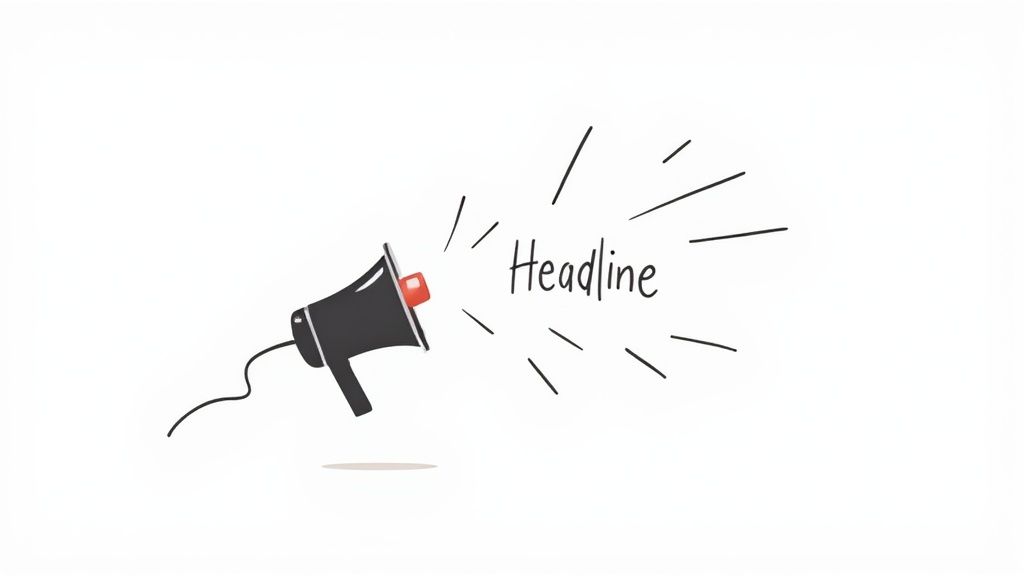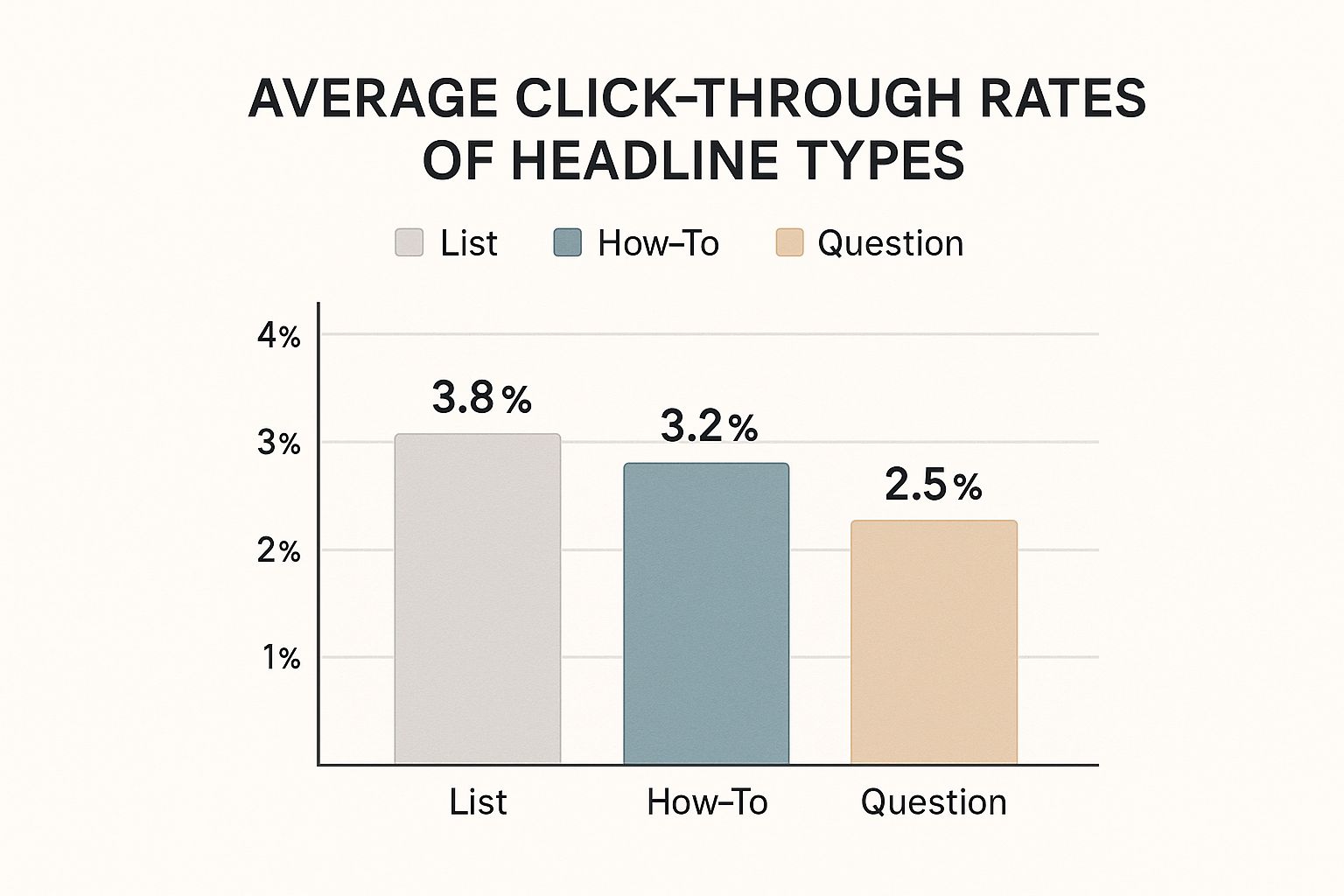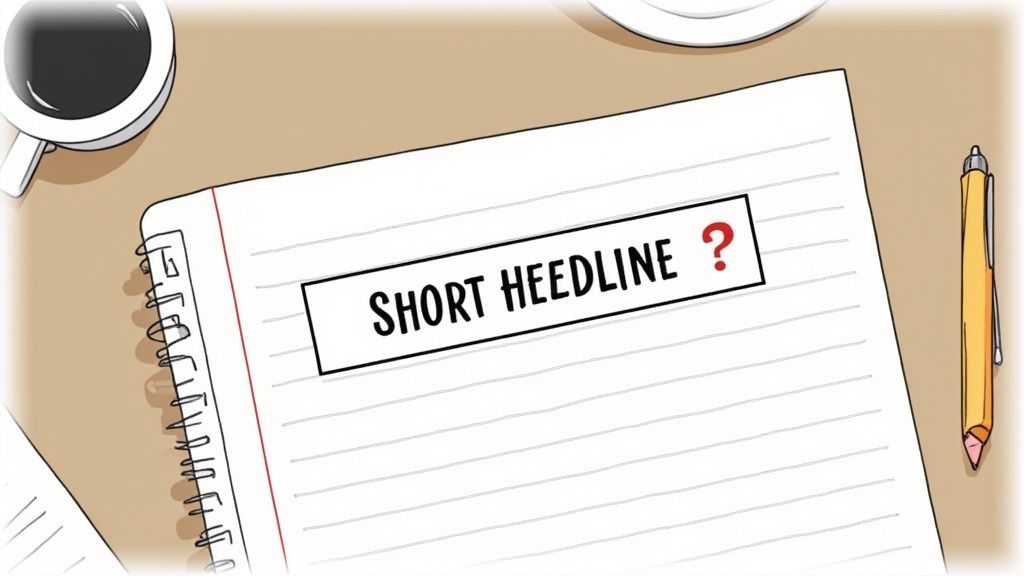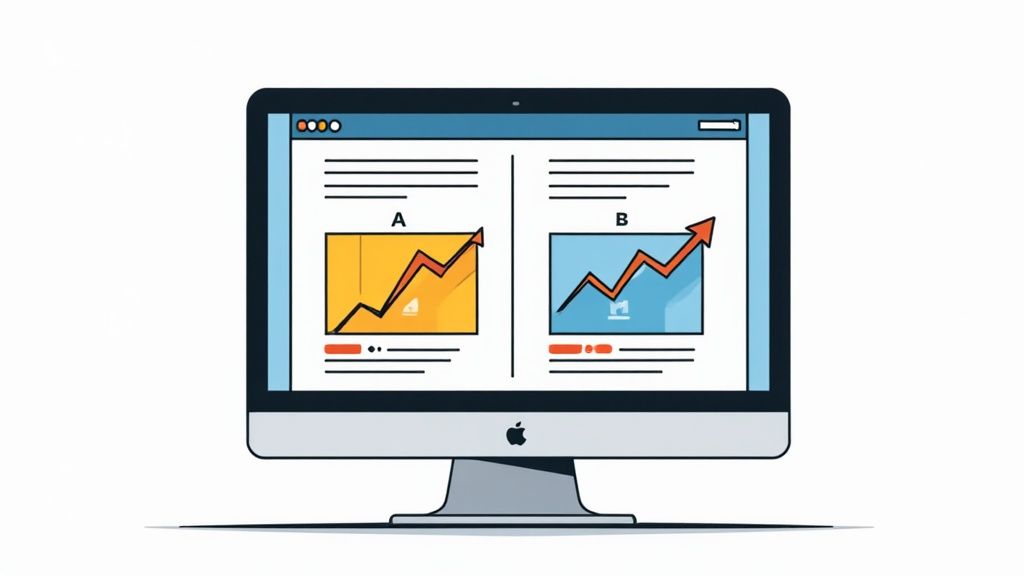How to Write Better Headlines to Capture Attention

Too many people treat headlines as an afterthought. That’s a huge mistake.
Think of it this way: your headline is the very first promise you make to your reader. It's the one thing that has to grab them and give them a compelling reason to click. A truly great headline walks a fine line between specificity and curiosity—it offers just enough information to signal value, but leaves the reader wanting the full story.
The Real Power of a Great Headline

Your headline is the gatekeeper to your content. Simple as that. It doesn't matter how brilliant, well-researched, or genuinely helpful your article is. If the headline is weak, your content is invisible.
It’s the single most important factor that decides whether someone scrolls right past or stops to click. The data doesn't lie: on average, 8 out of 10 people will read your headline, but only 2 out of 10 will actually read the rest. That single sentence carries an incredible amount of weight.
A powerful headline works on a psychological level. It sets expectations and makes a direct promise—maybe it’s a solution to a nagging problem, an answer to a burning question, or a piece of information they didn't know they needed.
Tapping into the Curiosity Gap
One of the most effective tricks of the trade is playing with the "curiosity gap." This is the space between what your readers already know and what they want to know. A killer headline introduces a piece of information but strategically holds back the conclusion, creating a mental itch that can only be scratched by clicking.
For example, a headline like "Tips for Productive Mornings" is fine, but it’s forgettable.
Now, try this instead: "The One Morning Habit That Sabotages Your Entire Day." See the difference? It immediately creates a sense of curiosity and urgency. It implies the reader might be making a common mistake and positions your content as the only way to find out what it is.
Your headline is your first—and sometimes only—chance to convince a reader that your content is worth their time. It's not just a label; it's a strategic tool for engagement.
Ultimately, mastering headlines means understanding this dynamic. It’s a blend of crystal-clear communication and a bit of psychological appeal. And this principle doesn't just stop with your on-page title. Learning how to write meta descriptions that boost clicks is the other half of the equation, amplifying your headline's power in the search results. Every single word has to work hard to earn that click.
Mastering the Core Elements of Effective Headlines
Before we dive into specific formulas, let's get the fundamentals down. You can have all the templates in the world, but if you don't grasp why they work, you're just throwing darts in the dark. The best headlines are built on a solid foundation of clarity, specificity, and a little bit of urgency.
Think about it. A headline like "Marketing Tips" is completely forgettable. It's a lazy promise. But what if you saw "5 Actionable Email Marketing Tips for This Week"? Now we're talking. You know exactly what you're getting, how many tips there are, and that you can use them right away. That specificity builds instant trust.
Triggering an Emotional Response
Logic gets the click, but emotion is what makes them want to click. Great headlines don't just state facts; they tap into curiosity, promise a clear benefit, or even poke at a common pain point.
This is where the art of copywriting really shines. Using "power words"—terms that imply ease, exclusivity, or a quick solution—can make a huge difference in your click-through rates. It’s a core concept, and if you’re new to the game, getting a handle on the basics will make everything else fall into place. For more on that, you can find a solid primer right here: https://www.lumeo.me/en/blog/copywriting-for-beginners.
The image below breaks down the click-through rates for different headline types, and it really shows how much structure matters.

It’s no surprise that lists and "how-to" headlines are top performers. They make a clear, simple promise of organized and helpful information.
To help you put this into practice, here's a simple table breaking down the key components of a strong headline.
Headline Element Effectiveness
This table outlines the core parts of a headline and shows how each one contributes to grabbing a reader's attention.
| Element | Purpose | Example |
|---|---|---|
| Numbers & Data | Provides specificity and sets clear expectations. | 7 Ways to Boost Your Productivity |
| Action Verbs | Creates a sense of urgency and empowerment. | Master Your Morning Routine |
| Benefit-Oriented Language | Answers the reader's "What's in it for me?" question. | The Secret to Effortless Meal Prep |
| Intrigue | Sparks curiosity by creating a knowledge gap. | Why Your Current Strategy is Failing |
| Keywords | Aligns with user search intent for better SEO. | A Beginner's Guide to SEO Content |
Think of these elements as your ingredients. The best headlines mix and match them to create something compelling.
Putting It All Together
Your real goal is to blend these elements together. You need to be clear enough for someone to get the gist in a split second but intriguing enough that they can't help but click. It's a fine line between giving away just enough information and holding a little something back.
A great headline doesn’t just describe your content; it sells it. Each word must justify its place by either adding clarity, sparking curiosity, or promising a tangible benefit to the reader.
Once you’ve got these principles down, you can craft compelling headlines on the fly. And if you're looking to go even deeper on creating content that performs from top to bottom, these actionable SEO content writing tips are a fantastic next step. With this foundation, you can stop relying on templates and start thinking like a true copywriter.
Using Numbers to Create Immediate Impact

There's a simple reason why numbered headlines work so well: our brains are hardwired to love order and clarity. When we're scrolling through a sea of words, a number pops out. It’s a signpost, a clear promise of what we're about to get.
Think about it. When a reader sees a headline like "7 Ways to..." or "3 Steps to...", their brain instantly recognizes the structure. It feels organized and easy to digest, which is a huge advantage when you have only a split second to grab someone's attention.
This approach strips away the uncertainty. Instead of a vague, potentially complex article, you’re offering a neat, scannable list. This is the magic behind the endless popularity of listicles—they promise efficiency and tangible takeaways without the fluff.
How to Use Numbers Effectively
Of course, just slapping a number on a title isn’t the whole story. The real power comes from making it specific and compelling.
A generic title like "Ways to Improve Your Website" is easily ignored. But something like "5 Quick Fixes to Boost Your Website Speed"? That's far more powerful. It’s specific, promises a clear benefit, and sets a finite scope for the reader.
Here are a few ways I put numbers to work in my headlines:
- The Classic Listicles: You can't go wrong with this format. Example: "11 Common Mistakes to Avoid in Your Next Blog Post."
- Data-Driven Headlines: Using a specific statistic is an instant authority-builder. Example: "How We Increased Signups by 47% With One Simple Change."
- Numbered Guides: These signal a straightforward, step-by-step process. Example: "Your 3-Step Guide to Launching a Successful Podcast."
The beauty of a number in a headline is its ability to provide immediate clarity. It tells the reader exactly what to expect, making your content feel less intimidating and more valuable from the very first glance.
And this isn't just a hunch; the data backs it up. Studies have shown that headlines with precise figures can significantly increase click-through rates because they signal concrete value.
For instance, reporting that an economic indicator rose by 5.4% year-over-year gives people actionable information they can trust. If you're curious, you can explore more data on how numbers influence reader behavior. It's a simple tactic that adds a layer of credibility that vague words just can't match.
Finding the Perfect Headline Length for SEO
Thinking about your headline's length might seem like a tiny detail, but it's a massive factor in both your SEO performance and whether a real person actually clicks.
If your title is too short, you’re likely missing out on crucial keywords and context that search engines need to rank you. Go too long, and your carefully crafted title gets awkwardly cut off in the search results, killing its impact. You’ve seen it happen.
The sweet spot is everything.
Time and again, research shows that headlines clocking in at 6 to 13 words pull in the most traffic. This range gives you just enough room to be specific, drop in your primary keyword, and intrigue the reader without being a mouthful. For search engines, understanding what is a meta title and how it affects SEO is non-negotiable, since that's what people see first.
The Data-Backed Sweet Spot
When you look at the numbers, the picture gets even clearer.
Headlines between 10 and 13 words have been shown to attract twice as much traffic and snag 1.5 times more shares than titles under seven words. Why? A slightly longer, well-thought-out headline does a much better job of communicating the value inside. It promises a real solution, making it far more compelling to click.
We've all seen headlines get chopped off by Google, ending with a sad little "..." That ellipsis can hide the most important part of your message, sinking your click-through rate before you even had a chance.
Your mission is to be concise but descriptive. Sticking to that proven word count is a fantastic starting point, but clarity should always be your top priority. Getting this right is a cornerstone of smart writing, and you can dig into more strategies with our content optimization tips.
One last tip I've picked up over the years: odd-numbered listicles tend to outperform even ones. There's just something about the asymmetry that catches the eye. A title like "7 Ways to..." often feels more authentic and gets more clicks than "8 Ways to..." It's a small psychological tweak, but the results can be surprisingly powerful.
Adapting Your Headlines for Social Media

A headline that crushes it for SEO can completely fall flat on social media. It's a totally different ballgame.
On platforms like Twitter, Facebook, or LinkedIn, you aren't just up against other articles. You’re fighting for a few seconds of attention against memes, vacation photos, and viral videos in a never-ending feed.
This means your priorities have to shift. Brevity and shareability are king. Your carefully crafted, keyword-rich blog title needs a makeover to become punchy, conversational, and impossible to ignore. You're trading detailed descriptions for immediate impact.
Think of it this way: your blog headline is the formal introduction. Your social media headline is the opening line you'd use at a loud party—it has to cut through the noise, and fast.
Tailoring Your Approach for Different Feeds
Every social media platform has its own vibe and audience expectations. What works on one won't necessarily work on another. A professional, benefit-driven hook can do wonders on LinkedIn, while a provocative question is more likely to take off on Twitter. It's all about adapting your core message to fit the context.
Let’s see how a single blog title can be transformed:
- Original Blog Title: "10 Advanced Strategies to Improve Your Content Marketing ROI"
- Twitter Version: Is your content marketing actually making you money? Here are 10 strategies most people miss. #ContentMarketing #MarketingROI
- Facebook Version: Feeling like you're just creating content for nothing? We broke down 10 powerful strategies that can seriously boost your ROI. Here's a peek at the first one...
- LinkedIn Version: For professionals looking to maximize their content marketing investment, these 10 advanced strategies offer a clear roadmap to improving ROI in the next quarter.
See how the tone and framing change for each platform? For LinkedIn specifically, you can use a LinkedIn hooks generator to quickly spin up openers that grab the attention of a professional audience.
The key to social media headlines is to start a conversation, not just make a statement. Spark curiosity, ask a question, or state a bold claim that makes people want to weigh in.
Data shows that the sweet spot for a shareable social headline is around 11 words. On top of that, shorter Facebook posts and tweets (think 100-115 characters) see way more engagement. Every single character counts.
Of course. Here is the rewritten section, crafted to sound like it was written by an experienced human expert.
Your Top Headline Questions, Answered
Even with a solid playbook of formulas and tactics, you're bound to run into a few tricky spots when it’s time to actually write. Let’s clear up some of the most common questions that pop up.
How Many Headlines Should I Really Write for One Article?
I'm going to give you a number, and it might sound a little crazy at first: 25.
Yes, you should aim to write at least 25 headlines for every single piece of content you create. The goal here isn't just to hit a number; it's to force your brain past the first, most obvious ideas. Your first five will be easy. The next ten will be a little tougher. But those last ten? That’s where the magic happens.
This process pushes you to explore totally different angles, play with emotional triggers, and experiment with formats you wouldn't have considered otherwise. It’s the single best habit you can build to go from a “good enough” headline to one that genuinely stops people in their tracks.
What's the Real Difference Between a Headline and a Title Tag?
This is a big one, especially if you care about getting traffic from Google. They sound similar, but they do two completely different jobs.
Your headline (technically your H1 tag) is what people see at the very top of your article once they're already on the page. Its one and only job is to be compelling enough to make them say, "Okay, I'm in the right place, I want to read this."
The title tag, however, is what shows up in the browser tab and—most importantly—as that big blue clickable link in Google's search results. This one is for Google and the searcher. It needs to be crystal clear, keyword-focused, and short enough not to get cut off (under 60 characters is the gold standard).
Think of it like this: The title tag is the movie trailer that gets you into the theater. The headline is the opening scene that hooks you for the rest of the film. You absolutely need both.
So, Is Clickbait Ever Okay?
We need to draw a hard line between creating curiosity and flat-out lying.
Classic clickbait is the stuff that makes a huge, unbelievable promise and then completely fails to deliver. That’s a fast track to destroying your credibility. Readers feel duped, they bounce immediately, and search engines take note of that bad user experience.
But there's a powerful—and ethical—alternative: the curiosity gap. A great curiosity-driven headline makes a compelling promise that the content actually delivers on. You're sparking interest and creating a little bit of tension that can only be resolved by reading the article.
As long as you follow through and provide real value, you’re not tricking anyone. You’re just being a smart marketer. The difference comes down to honesty and delivering on your promise.
Ready to turn your best ideas into visually stunning, high-engagement content? Lumeo helps you effortlessly transform articles, tweets, and videos into compelling carousels perfect for LinkedIn and Instagram. Start creating for free and see the difference. Discover Lumeo today!